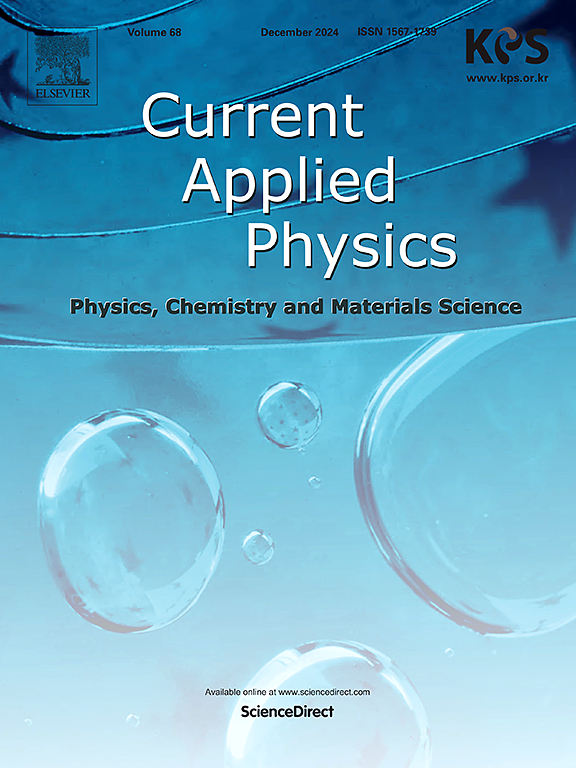通过Mn掺杂调整PNT-PZT陶瓷的电学性能和热稳定性
IF 3.1
4区 物理与天体物理
Q3 MATERIALS SCIENCE, MULTIDISCIPLINARY
引用次数: 0
摘要
本文对掺锰0.12PNT-0.88PZT陶瓷的结构、介电和压电性能进行了全面的研究。x射线衍射(XRD)证实在所有成分中都形成了纯钙钛矿四方相。Mn的加入对陶瓷的介电、铁电、压电等功能性能有显著影响。值得注意的是,掺1.5 mol% mn的0.12PNT-0.88PZT组合物的性能得到了增强,达到了r = 2838, Pr = 15.2 μC/cm2, d33 = 440 pC/N,而掺2.5 mol% mn的组合物的Qm达到了730。介质响应的瑞利分析表明,外部贡献(由瑞利参数(α)量化)在Mn掺杂浓度为1.5 mol%时达到峰值。这些发现表明,随着外部效应的增强,畴开关和晶界对电学性能的贡献越来越占主导地位。此外,掺锰量为1.5 mol%的0.12PNT-0.88PZT陶瓷在室温至120℃的较宽温度范围内,在压电系数、机电耦合系数和机械质量因子方面表现出优异的温度稳定性。这项工作为Mn掺杂在增强PNT-PZT陶瓷功能特性中的作用提供了重要的见解,并强调了其在不同热条件下需要稳定性能的应用潜力。本文章由计算机程序翻译,如有差异,请以英文原文为准。

Tailoring electrical properties and thermal stability of PNT-PZT ceramics via Mn doping
This study presents a comprehensive investigation of the structural, dielectric, and piezoelectric properties of Mn-doped 0.12PNT-0.88PZT ceramics. X-ray diffraction (XRD) confirms the formation of pure perovskite tetragonal phases in all compositions. The incorporation of Mn exerts a pronounced influence on the functional properties of the ceramics, including dielectric, ferroelectric and piezoelectric properties etc. Notably, the 1.5 mol% Mn-doped 0.12PNT-0.88PZT composition demonstrates enhanced performance, achieving ɛr = 2838, Pr = 15.2 μC/cm2, d33 = 440 pC/N, while the 2.5 mol% Mn-doped variant achieves an exceptional Qm of 730. Rayleigh analysis of the dielectric response reveals that the extrinsic contribution, quantified by the Rayleigh parameter (α), peaks at a Mn doping concentration of 1.5 mol%. These findings indicate that as extrinsic effects intensify, domain switching and grain boundary contributions to the electrical properties become increasingly dominant. Furthermore, the 1.5 mol% Mn-doped 0.12PNT-0.88PZT ceramics demonstrate excellent temperature stability in piezoelectric coefficient, electromechanical coupling factor, and mechanical quality factor over a broad temperature range from the room temperature to 120 °C. This work provides critical insights into the role of Mn doping in enhancing the functional properties of PNT-PZT ceramics and highlights its potential for applications requiring stable performance under varying thermal conditions.
求助全文
通过发布文献求助,成功后即可免费获取论文全文。
去求助
来源期刊

Current Applied Physics
物理-材料科学:综合
CiteScore
4.80
自引率
0.00%
发文量
213
审稿时长
33 days
期刊介绍:
Current Applied Physics (Curr. Appl. Phys.) is a monthly published international journal covering all the fields of applied science investigating the physics of the advanced materials for future applications.
Other areas covered: Experimental and theoretical aspects of advanced materials and devices dealing with synthesis or structural chemistry, physical and electronic properties, photonics, engineering applications, and uniquely pertinent measurement or analytical techniques.
Current Applied Physics, published since 2001, covers physics, chemistry and materials science, including bio-materials, with their engineering aspects. It is a truly interdisciplinary journal opening a forum for scientists of all related fields, a unique point of the journal discriminating it from other worldwide and/or Pacific Rim applied physics journals.
Regular research papers, letters and review articles with contents meeting the scope of the journal will be considered for publication after peer review.
The Journal is owned by the Korean Physical Society.
 求助内容:
求助内容: 应助结果提醒方式:
应助结果提醒方式:


